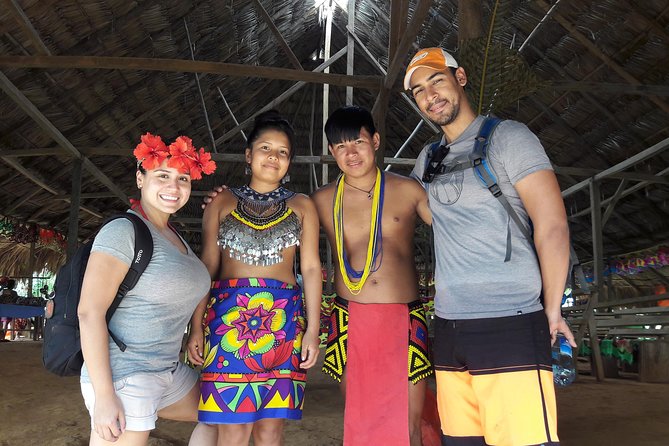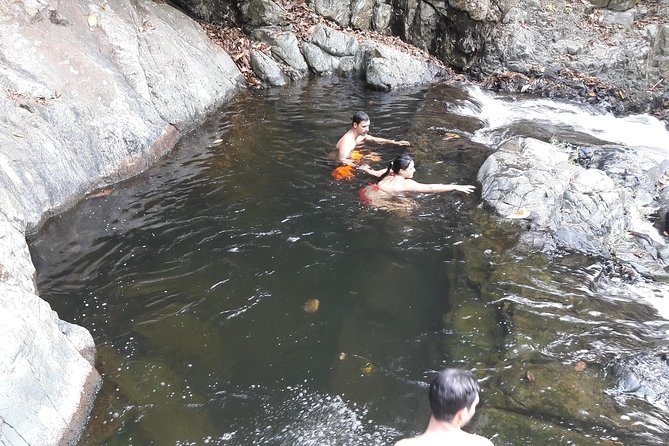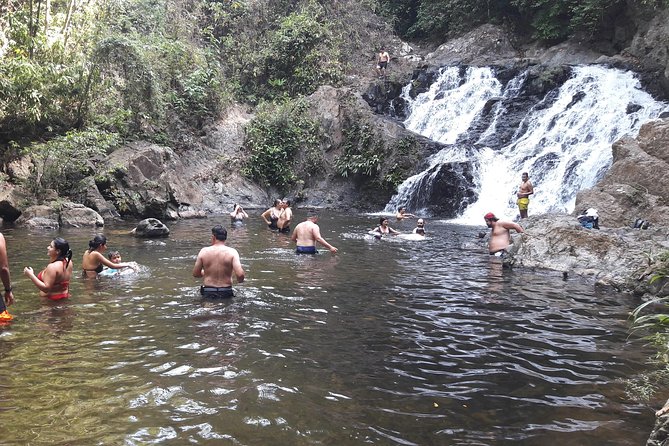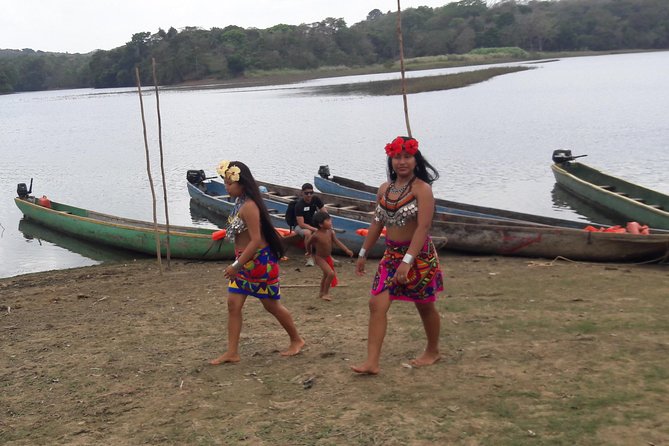The Embera people, indigenous to the lush Darien region of Panama and Colombia, have nurtured a vibrant culture steeped in time-honored traditions. From their intricate basket weaving to expressive music and dance, the Embera way of life reflects a deep reverence for the natural world and a steadfast commitment to preserving their ancestral heritage. Embera villages are hubs of communal living, where sustainable practices and collective decision-making shape the rhythm of daily life. Beyond the captivating artistry and customs, the Embera’s story offers a glimpse into the enduring resilience and cultural richness that defines their identity.
Key Points

-
The Embera are an indigenous group known for their intricate basket weaving, vibrant body painting, and strong connection to their ancestral land and beliefs.
-
Embera traditional dress features colorful hand-woven textiles, beadwork, and symbolic accessories that reflect their rich cultural heritage and connection to nature.
-
Embera villages are characterized by thatched-roof huts and communal spaces, where sustainable living and collective decision-making are prioritized.
-
Embera arts and crafts, such as woodcarvings and textiles, serve functional purposes while showcasing their cultural identity and preserving their unique heritage.
-
Embera music and dance are integral to their spiritual beliefs and connection to nature, expressing stories of their ancestors and celebrating the cycles of the natural world.
Who Are the Embera People?

The Embera people are an indigenous group native to the Darien region of Panama and neighboring parts of Colombia. They’re known for their intricate basket weaving, vibrant body painting, and unique cultural traditions.
The Embera live in small, isolated villages along the rivers and rainforests of the Darien. They maintain a close connection to the land, practicing subsistence farming, fishing, and hunting. Their language, Embera, is part of the Chocó linguistic family.
Today, the Embera strive to preserve their traditional ways of life while adapting to the changing modern world. Visitors can enjoy Embera culture by participating in cultural tours and experiencing their traditional way of life firsthand.
You can also read our reviews of more tours and experiences in Panama City.
Embera Traditions and Customs

Rich cultural traditions and customs are deeply woven into the fabric of Embera society. The Embera people maintain a strong connection to their ancestral land and beliefs.
Traditional dress, such as intricate beadwork and vibrant textiles, reflects their cultural identity. Rituals and ceremonies, often involving music and dance, play a central role in Embera life, marking important events and honoring their spiritual traditions.
The Embera are known for their skilled craftsmanship, producing handmade baskets, pottery, and woodcarvings that are highly valued. These practices demonstrate the Embera’s commitment to preserving their heritage and passing it on to future generations.
Embera Attire and Accessories
Embera attire and accessories are a vibrant and distinctive part of their cultural identity. The Embera people are known for their intricate and colorful hand-woven textiles, which they use to create traditional clothing and accessories.
Women often wear long dresses or skirts made from brightly patterned fabrics, complemented by beaded necklaces, earrings, and bracelets. Men may wear loin cloths or shorts, along with woven hats and decorated wooden masks.
These items aren’t only functional but also hold deep symbolic meaning, representing the Embera’s connection to their natural environment and spiritual beliefs. The attention to detail and craftsmanship in Embera attire is a testament to the rich cultural heritage of this indigenous group.
Embera Village and Lifestyle

Beyond the vibrant attire and accessories, the Embera people’s unique village lifestyle is a captivating aspect of their culture. Nestled deep within the Panamanian rainforest, Embera villages offer a glimpse into a traditional way of life. Thatched-roof huts, communal gathering spaces, and a reliance on natural resources characterize the Embera’s sustainable living.
| Village Life | Harmony with Nature | Cultural Traditions |
|---|---|---|
| Communal Huts | Fishing and Hunting | Storytelling |
| Artisan Crafts | Harvesting Crops | Music and Dance |
| Shared Meals | Medicinal Plants | Ceremonial Rituals |
| Cooperative Tasks | Respecting the Land | Passing Down Knowledge |
| Collective Decision-making | Sustainable Practices | Honoring Ancestors |
Embera Arts and Crafts
The Embera people’s artistic traditions are deeply woven into the fabric of their cultural identity. From vibrant textiles to intricate woodcarvings, their creations showcase the ingenuity and artistry of this indigenous group.
Weaving is a particularly significant art form, with Embera women using natural dyes and intricate patterns to craft colorful fabrics, baskets, and bags.
Plus, the men are skilled in woodcarving, producing intricately detailed masks, figurines, and other decorative items.
These artworks not only serve functional purposes but also hold deep symbolic meaning, reflecting the Embera’s connection to their natural environment and rich cultural heritage.
Through their arts and crafts, the Embera people continue to preserve and share their unique identity with the world.
Embera Cuisine and Culinary Practices
Along With their rich artistic traditions, the Embera people have a distinct and flavorful cuisine that reflects their deep connection to the land.
A staple of the Embera diet is plantains, which are boiled, fried, or mashed into a porridge. They also rely on locally sourced fish, rice, and an array of tropical fruits and vegetables.
Cooking techniques often involve steaming, roasting, or smoking over an open fire. Embera meals are typically served communally, fostering a sense of togetherness.
Their culinary practices aren’t only nourishing but also serve as an integral part of their cultural identity and traditions.
Embera Music and Dance
Music and dance hold a central place within Embera cultural traditions, serving as powerful expressions of their spiritual beliefs and connection to the natural world.
The Embera’s rhythmic music, which often features drums and wind instruments, accompanies vibrant dances that tell stories of their ancestors and their relationship to the rainforest.
In traditional ceremonies, the Embera perform intricate dances that mimic the movements of animals, celebrate the cycles of nature, and invoke the blessings of their deities.
These artistic expressions aren’t just entertainment, but vital components of Embera cultural identity and spirituality, passed down through generations as a means of preserving their unique heritage.
Experiencing the Embera Culture
For visitors to Panama, immersing oneself in the vibrant Embera culture offers a profound and enriching experience.
The Embera people, known for their intricate basket-weaving, artistic face painting, and traditional music and dance, welcome guests into their riverside villages. Visitors can explore the lush rainforest, learn about medicinal plants, and witness the community’s daily life.
Partaking in an Embera culture tour often includes a boat ride, a traditional lunch, and the opportunity to purchase handcrafted souvenirs.
Through this immersive experience, travelers gain a deeper appreciation for the Embera’s rich heritage and their harmonious connection with the natural world.
Frequently Asked Questions
What Is the Duration of the Embera Culture Tour?
The Embera Culture tour is a full-day experience, lasting approximately 8-10 hours. The tour departs at 6:30 AM and returns to the original meeting point, providing ample time to immerse in the local Embera traditions and lifestyle.
Can I Bring Children on the Embera Culture Tour?
Yes, children can be brought on the Embera Culture tour. However, infants must sit on laps as the tour is not wheelchair accessible. Parents should ensure their children have the required moderate physical fitness level for the tour.
What Is the Cancellation Policy for the Embera Culture Tour?
The Embera Culture Tour offers free cancellation up to 24 hours before the scheduled start time. Guests can easily reserve the tour with the "Reserve Now and Pay Later" option, providing flexibility in their travel plans.
Is Transportation Provided for the Embera Culture Tour?
Yes, transportation is provided for the Embera Culture Tour. The tour includes an air-conditioned vehicle to transport participants to and from the meeting point, as well as bottled water throughout the experience.
What Is the Group Size for the Embera Culture Tour?
The Embera Culture Tour has flexible group sizes. Prices vary based on the number of participants, with a minimum of 2 people required. The tour is operated by Panama Outdoors and provides an air-conditioned vehicle for the experience.
Recap
The Embera people’s vibrant cultural traditions and deep connection to nature have endured for generations. Through their arts, crafts, cuisine, and communal way of life, they preserve their unique identity and ancestral heritage. By experiencing the Embera’s immersive cultural offerings, visitors gain a profound understanding of this remarkable indigenous group’s resilient and sustainable way of life in the Darien region.
More Tour Reviews in Panama City
- Pelicano Island: Day Trip (Casa Del Papel) San Blas Panama
- Hourly Transportation for Small Groups in Panama – Tour, Layover or Business
- Gamboa Aerial Tram and Sloth Sanctuary
- 1- or 2-Night Experience in San Blas Islands
- Day Tour: Rainforest, San Lorenzo Fort and The Panama Canal
- Romantic Camping in San Blas Islands
Not for you? Here's more things to do in Panama City we have recnetly reviewed
- 10 Best Canoe And Kayak Experiences In Panama City
- 4 Best Dining Experiences In Panama City
- 3 Best 2 Day Tours In Panama City
- 4 Best Dinner Tours In Panama City
- 10 Best Canoe And Kayak Experiences In Panama City
- 25 Best Cruises And Boat Tours In Panama City
- 8 Best Food Tours In Panama City
- 15 Best Full-Day Tours In Panama City
- 2 Best 3 Day Tours In Panama City
- 3 Best 4 Day Tours In Panama City
- 2 Best Coffee Tours And Tastings In Panama City
- 7 Best Lunch Experiences In Panama City
